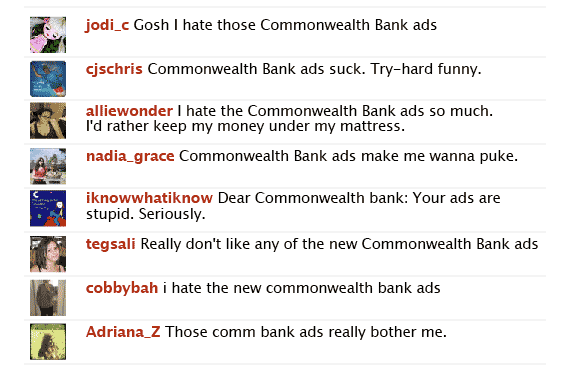Imagine you work at Commonwealth Bank. You’ve just launched a multi-million dollar ad campaign for a while and you want to see if it’s generating any “social buzz.” So you hop on Twitter, only to find this:
 A sampling of actual tweets about Commonwealth Bank’s
A sampling of actual tweets about Commonwealth Bank’s
latest ad campaign taken January 2011.
What would you do if it seemed like everyone hated your ads? Would you gut it out? Or would you give into the knee-jerk instinct to pull the campaign immediately?
Unlike most management teams in the financial industry, that’s not what Commonwealth did. The bank’s thick-skinned leaders are stuck to their guns. Even when research concluded that 30% of the entire country hated their ads, the bank still wouldn’t back down.
That takes balls.
There are plenty of banks and credit unions where one or two complaints is all it takes to kiss an entire ad campaign goodbye forever.
Commonwealth’s marketing team are no strangers to controversy. Indeed, they seem to enjoy stoking the fire. Back in 2008, they debuted an ad campaign that was so bad, it actually mocked itself. Even though one out of every three people found the spots annoying, Commonwealth’s brand awareness grew from 70% to 95% while cutting the media budget by a third.
Commonwealth broke its latest campaign in 2010, but it hasn’t fared any better. Complaints have been streaming in for nearly three straight years now, so don’t expect a reversal in direction anytime soon.

Send the Right Offers to the Right Consumers
Achieve a better return on your marketing investment. Leverage behavioral data and analytics to target the right customers with the best possible offers.
Read More about Send the Right Offers to the Right Consumers

Industry Cloud for Banking from PwC
PwC’s Industry Cloud for Banking applies our deep industry knowledge to your specific business needs
Do irritating ads work better than funny ones?
Advertising is a funny business. Literally. Look at enough ad agency portfolios and you’ll see so much comedy that you’ll start to wonder if the only successful approach is humor. “Entertain the audience” seems to be the common theme underpinning the material. But what if funny, entertaining ads aren’t the most effective? Sure everyone talks about that “funny spot I saw last night,” but who was it for again? For instance, do you remember who was behind the “Herding Cats” Superbowl spectacular? And what they were advertising? (Hint: “Managing the complexities of the digital economy.”)
What if what we like to call “good ads” don’t work as well as the ads we don’t like? Maybe irritating is effective? After all, the parent company who permanently etched the expression, “HeadOn, apply directly to the forehead,” into our brains saw its sales shoot up 234% nearly overnight following the debut of its repetitive ad campaign. As much as you may hate Snuggie spots mixing the Macarena with karaoke, the blanket-with-sleeves has sold over 20 million units. And don’t forget “Clap on, clap off. The Clapper!”
HEAD ON – APPLY DIRECTLY TO THE FOREHEAD
Before you rush to judge this spot, remember that these six words repeated three times in just 11 seconds did more for this advertiser than probably all the ads you’ve ever run.
By comparison, Commonwealth’s current ads seem dull and uncontroversial. There isn’t much to get wound up over. The latest campaign is hardly as annoying. There certainly isn’t much complain about as far as Commonwealth’s visual aesthetics and soundtrack are concerned.
The downside to annoying ads?
Some ad experts think advertisers need to worry about more than just sales.
“I think that irritating ads could pose a longer-term danger to the brands that use them,” notes Roger Dooley, a marketing consultant and author of Neuromarketing. “At the cognitive level, I find myself repelled by an advertiser bold enough to acknowledge that their ads are annoying me, and then continue to assault me with the objectionable elements in the same ad.”
“The real danger, though, doesn’t really involve conscious processing by the viewers,” Dooley continues. “If viewers begin to associate the brand or packaging with the negative emotion of a loud and annoying interruption of their entertainment, eventually the brand will suffer.”
“Companies like Coca Cola and Anheuser-Busch know something about building long-term brands, and most of their ads are suffused with positive emotions,” Dooley concludes. “Then again, they have the budget and time to think long-term.”

Conclusion and takeaways
Don’t abandon your approach just because you encounter some vocal detractors. Branding is about differentiation, not mass appeal. If your brand strategy is focused around a specific audience segment, obviously your ads won’t jive with everyone. Many years ago, the direct mail industry said you should shoot for a 2% response rate. Not anymore. These days, it’s almost as if you should set out to make 2% of your audience mad. At least that way, you can be certain people are paying attention and taking notice.
In some ways, you could almost consider yourself lucky if people hate your ads. Most ads trigger no reaction at all. Ads that no one finds objectionable don’t work, and ad strategies that don’t spark internal arguments among your management team aren’t usually worth pursuing. When people are annoyed by your “horrible ads,” you may have actually hit an advertising sweet spot.







